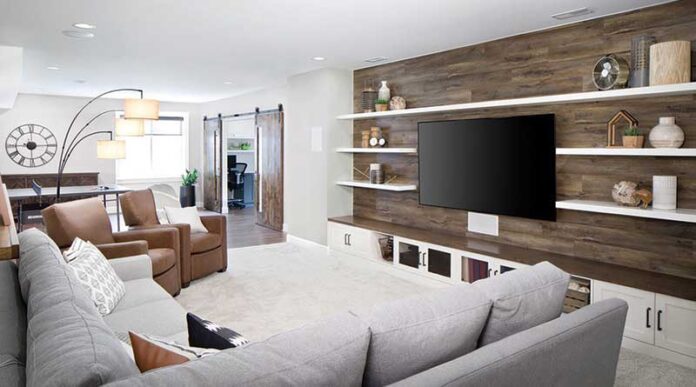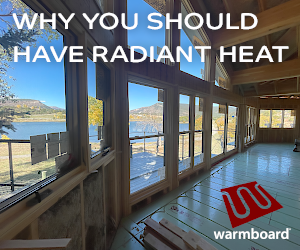What trends are popular in home design?
With 2024 right around the corner, architects and builders in the Colorado area are already looking toward the future of home building. While new patterns are always emerging, some changes aren’t your typical one-hit-wonder trends. Three local builders and architects share five new home design trends that hold some serious staying power.
Small is big
When Cherie Goff, owner and architect at Cgmodern Architecture, starts designing a home that intends to tread lightly on the planet, she starts with size. “Designing an efficient home uses less materials and makes the home more livable,” Goff says. “I start each project by exploring what spaces are important for my clients and what are the right sizes for each space.”
If the kitchen and living room are the most important for her clients, she makes those rooms the most special while minimizing resources, such as space and material, in secondary rooms. “For example, does the primary bedroom really need to be extra large, or is it really just used for sleeping?” Goff asks. “Also, what spaces can be combined or eliminated? Is a separate room for an office really needed, or is a nook off a quiet hallway just as good or better?”
Designing a house that is sized for what is truly needed and wanted—without added bonus rooms and unnecessary spaces—reduces not only the materials consumed but also the amount of energy needed to heat and cool the space.
Related: Forge & Bow, Design-Build Firm
She’s seeing a backlash against oversized dwellings and finds that many clients come to her because they can’t find a quality home that feels appropriately sized. They’re also looking for homes that aren’t just comfortable to live in but were built with quality materials and offer indoor-outdoor living space.
“The real estate market has rewarded larger homes with higher selling points, which has led to homes with oversized rooms that were bigger but not better,” Goff says. She finds that big, boxy homes are changing the character of neighborhoods and has noticed that some communities are starting to restrict the size of homes people can build. “Zoning regulations are being adapted to encourage the building of homes that complement the neighborhoods rather than maximize square footage.”
Informal spaces are in
Remember how formal dining rooms and living areas used to be? Today’s homeowners want a home designed around how they actually live, not how a house dictates they should. Even million-dollar homes are forgoing formal dining rooms. Nothing is mandatory. Homes that were once made to be “showy” are now serving to be places meant to connect with friends and family.
Adrian Wisniewski, project development manager at Melton Design Build, says the changes are different for each family but believes rising home costs over the past few years have played a major part in it. “The more expensive the square footage, the less unused ancillary spaces we will find in a home,” he says. “The days of formalized sitting rooms and plastic-covered couches are gone.”
Wisniewski says that while minimalism was once a practice only for the “crunchiest,” it’s become much more mainstream. “We may not all be moving out of our 4,000-square-foot homes into tiny homes, but we certainly understand that having more stuff can create more stress,” he says. “This new view on life can also find its way into our homes.”
The other reason he says formal spaces are losing popularity is due to how the pandemic recalibrated homeowners’ priorities. Many are no longer taking time with their families for granted. “Similar to the recent focus towards more outdoor living spaces, we want to repurpose these less-used formal spaces into more energized, activated extensions of our home,” Wisniewski says. “Maybe it’s a game room or a place for kids to do homework closer to the main living spaces. We want to be close to each other and we want the time we spend together to mean something.”
He says that his company is also seeing a higher demand for houses where homeowners can age in place, which might require turning a first-floor sitting room or formal office into a primary bedroom to extend the length of time homeowners can stay put.
Home offices now essential
Bye-bye nicety, hello necessity. Wisniewski says new home offices don’t look anything like the formal ones of the past. Homeowners want to work from home without giving up beneficial living space. New home offices can be a well-thought-out nook tucked away in a low-traffic area, a dedicated office space or a flex room that serves multiple purposes.
Related: Home Tech Innovation for 2024 and Beyond
“There are far less coffered ceilings and miles of built-in bookshelves and, instead, those have been replaced with small pocket offices that provide just enough room to make your Zoom calls and get some focused space,” Wisniewski says. “Soundproofing and privacy are a must, particularly for young families with children, and ideally some natural lighting and view corridors. Even for those of us that have gone back to the office, we have realized over the past few years that we can work anywhere we need to and within the hours we prefer most. A small office in the home provides the freedom to work on our schedules versus the antiquated nine to five.”
Environment matters
In our post-pandemic world, people are spending more time than ever at home. Increasing a sense of well-being at home can include obvious elements, such as ensuring clean air, as well as more subtle efforts, like incorporating more natural light and creating a feeling of greater connection to nature.
“Living in Colorado, biophilia is a huge trend as we know that being in nature elevates our mood and makes us feel connected to the world around us,” Goff says. “We can bring the outside into our homes by blurring the boundary to the outside with floor-to-ceiling windows and indoor-outdoor spaces. This is true whether it is in the city or in the mountains. We want to feel that connection.”
Designs are also keeping the larger environment in mind. “Designing buildings that are more responsible to our environment is becoming an industry standard, not a luxury or an add-on to get a plaque on your wall anymore,” says Joey Pruett, founder and creative director of A21.
“The energy codes in the new editions of the IBC are getting more and more aggressive in insulating our buildings, which should result in a huge savings in our buildings’ energy usage,” he says.
Goff appreciates how much easier passive design considerations can be woven into the design processes “without compromising the design aesthetics” like they used to. Incorporating passive elements can be as simple adding more windows to the east side to help warm the house in the morning or controlling afternoon heat gain by including more shades.
Increasing insulation and sealing efforts can provide high returns with relatively low starting costs. “Some window manufacturers are now making windows with nearly the same thermal performance as exterior residential walls before the 1970s,” Goff says.
Additionally, Pruett feels that between the devastation of the Marshall Fire and year-round fire warnings throughout the West, there aren’t any true fire-safe areas anymore. “We’re trying to be responsible by applying Class-A fire rating materials on all of our projects’ facades and roofs—which won’t necessarily save the buildings but will hopefully be helpful in saving lives if necessary,” Pruett says.
A return to master craftsmanship
As some buyers shift away from larger, mass-produced homes, they are leaning into bespoke options that create impact and make the environment sing.
“We are all becoming more conscious of our footprint on the earth, and I think that pours over into our homes,” Wisniewski says. “Sure, there will always be a market for cheap materials, but our clients seem to be leaning more towards quality materials that will last, both in style and in function, and less towards the cheapest solution.”
While solving a problem for half the cost might seem great at a glance, if it doesn’t hold up in the long run and requires repair or replacement, it could cost twice as much or more over time. Homeowners who plan to stay put while raising a family are more interested now in investing in something with a longer lifespan that contains an elevated level of craftsmanship.
Related: The Most Exciting Trend in Home Technology
Wisniewski is one of many construction professionals concerned that our industry is losing more professionals in the wood and metal art trades, “particularly as tract developments pervade and all that matters is budget and construction schedule.” His company tries to bring in younger carpenters to pair with seasoned craftsmen as a way to ensure practices aren’t dying as more master craftsmen approach retirement.
And Pruett notes his firm actively looks for opportunities in their designs to incorporate bespoke details executed by local artisans and craftsmen.
“These collaborations are integral to our design process, and we enjoy the opportunity to give a platform to our friends and colleagues to make a good project great,” Pruett says. “We think of these details as integrated pieces of art built into the spaces that make each of our projects completely unique and respond to our client’s lifestyles.”









Great article Emily, At Stonebridge Builders, we’re aligned with the emerging home design trends discussed in the article. We’ve long endorsed efficient home designs and informal spaces tailored to real-life needs. Our focus on sustainability matches the industry’s growing environmental considerations. We pride ourselves on collaborating with local artisans, ensuring our projects are both trendy and timeless.